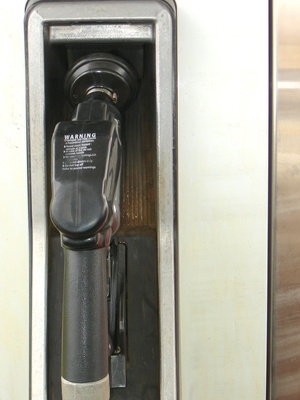
Fuel tanks are used in a variety of different vehicles, such as cars and motorbikes, and there are several issues that can arise with a fuel tank. The most common issue that arises with a fuel tank is that of leakage. There are lots of things that can cause a fuel tank to leak, and it is imperative to repair the tank in order to avoid fuel dripping out of it and excessive wastage. Furthermore, fuel tank leakage is also potentially dangerous because it is flammable, which is why it should be repaired as soon as a leak is spotted.
Remove the gasoline line from the tank using an open-ended wrench and needle-nose pliers. Place a plastic container under the tank and allow any remaining gasoline to drain into the container. Store the gasoline in a cool safe place.
Locate the electrical connector behind the vehicle's back bumper and disconnect it from the gas pump. This is done by using your hands to pull the connector straight out.
Remove the nuts in the the fuel tank straps with a socket wrench.
Set up two jacks, one at each end of the tank, to hold the fuel tank in place while you remove the vertical bolts. These bolts are located between the muffler and the gas tank. Unfasten the bolts with a socket wrench.
Place the gas tank on the ground below the vehicle. Disconnect the remaining hoses from the tank with a pair of pliers.
Remove the tank from under the vehicle and bring it to your work area. Pour a pint of acetone into the tank. This serves two purposes; it will take care of any remaining gas in the tank and it will aid in locating the leak.
Lift up the fuel tank while it is still filled with acetone to check how many leaks there are. If there are more than a few, a complete replacement should be considered as a viable option.
Mark the leaks with a water proof marker once all of the leaks have been found. Marking the leaks will make for a quicker repairing session later on.
Empty and dry the tank completely before beginning any repair work.
Apply epoxy glue on the markings that indicate where the leaks are.
Cover the glue completely with vacuum clay.
Apply metallic packing material over the glue. Use epoxy glue to stick the material to the covering.
Seal the edges with a soldering iron. Completely seal the edges by using the soldering iron on all sides of the metal packaging material.
Finalize the repairs with a welding gun. Completely weld the metallic packing material to ensure there is no chance of fuel leakage later on.
Check the tank after the repairs are complete to make sure all of the leaks have been fixed. This can be done by filling the tank with water. If there is still a leak, a complete tank replacement should be considered.